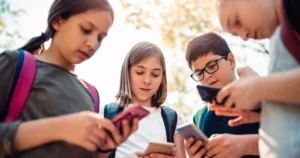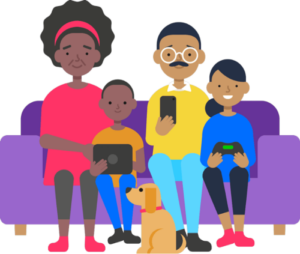As the Government reviews the school Curriculum, we highlight the importance of improving media literacy education.
Explore the current landscape and our recommendations for change.
In this article
- What the Government’s review of the Curriculum means
- Why does media literacy matter?
- What the media literacy curriculum looks like now
- What do we think should change?
- What happens next?
- Explore our research
What the Government’s review of the Curriculum means
We were really pleased to see that one of the first things on the new Government’s agenda was a review of the existing curriculum and assessment framework in English schools. This year-long review began in September 2024 and aims to make sure that all children and young people have access to a broad and balanced curriculum that sets them up for future life and work. This is a very important topic for us and was the subject of our recent Vision for Media Literacy Report.
The role of children’s digital life and habits
Children and young people’s online and offline lives are intertwined, as they regularly use the internet for education, friendship and creativity. Yet, our research shows that many children do not currently have all the skills they need to keep themselves and others safe online. ‘Media literacy’ refers to these skills.
We think schools are the perfect place to learn those skills. So, when the Government announced that they were conducting a public consultation as part of their review of the Curriculum, we shared our learnings about children’s and parents’ experiences online. We also included our recommendations for ensuring every child leaves school with the media literacy skills needed to thrive in a digital world.
Why does media literacy matter?
Children typically spend more than a whole day per week online. During that time, many experience harm. In fact, more than two-thirds of children tell us they have experienced some form of harm online.
We also know that some children are more likely to have negative experiences. For example, children with special educational needs (81%) are more likely to encounter harm online than their peers without these additional needs (70%).
Children need strong media literacy skills to safely use technology. This is key not just to keep children safe, but to helping tackle the spread of mis- and disinformation, as well as hate speech. These are also high-value skills for the future job market.
Children and parents have told us they think that good media literacy education is vital. In a survey of 1,000 children and 2,000 parents, 77% of children and 72% of parents felt that being taught how to stay safe online and identify trustworthy information is just as important as subjects like English and Maths.
What does the media literacy curriculum look like now?
At present, media literacy is taught across all year groups and across many subjects, like English, Computing and Media Studies. However, there is currently a significant variation across schools – and even different classes in the same school – on what children are taught and when.
This is because the guidance for teaching media literacy is split across many different documents. So, individual schools and staff hold responsibility to decide how its key areas should be taught. As a result, schools regularly take different approaches – and some are more effective than others.
Things can fall through the gaps and key knowledge areas and competencies are often overlooked altogether. One expert told us that, “I don’t think there’d be a coherent understanding . . . across the school sector, and that is in part because there’s never been an effective approach to media literacy within education.”
Additional challenges to consider
Alongside a lack of guidance, we also find other challenges to good media literacy education in the current curriculum. Teachers tell us at times they lack the confidence, knowledge and skills to teach certain topics. They also often don’t have the resources needed to teach media literacy well and must spend their own time looking for relevant and effective resources.
In an interview with us, one teacher commented that: “No one really tells you ‘this is the thing that the kids are using now, this is the social media’. I find PowerPoints really quickly go out of date. I get it out and it’s referencing something and they’re all like ‘Oh miss no one uses Snapchat anymore’. It does go out of date.”
This, coupled with limited oversight and assessment, means that there is little support for schools to teach media literacy well, especially in an environment with other competing pressures.
What do we think should change?
We believe that teaching media literacy at all levels and in a range of subjects is the right approach. This can ensure that children, regardless of what subjects they choose, have the skills to be safe and responsible citizens online. But to do this effectively, schools need clear guidance on how to deliver it across the curriculum.
We recommend that:
- Teachers are trained to teach media literacy skills and an easy-to-access hub of relevant resources is made for teachers of all key stages. We suggest that the Government collaborate with the tech industry and the third sector to fill this hub with up-to-date, engaging resources.
- Teachers are provided with adequate resources and training for vulnerable learners. We know that schools are underfunded, especially those with high levels of vulnerable children and Special Education Needs pupils. Yet, these pupils often suffer the most from poor media literacy.
- Children are taught about the aspects of media literacy that they will encounter as they get older before they are likely to encounter them, such as sexual image-sharing. Good and timely teaching around subjects like these can help prevent incidents.
- Media literacy learning is linked to formal or informal assessment at all ages and the Government provide oversight of quality media literacy teaching. We recommend that school inspectors be given new training to support media literacy being taught well in schools.
- The media literacy curriculum is designed to enable parents to take a more active role in supporting their children’s online safety. We know that parents are usually children’s first port-of-call for information about what they see online.
Our research shows that these changes would better prepare children for life after school and teach them to navigate the online world more safely and responsibly.
What happens next?
In early 2025, the panel of experts that are overseeing the Curriculum Review will publish a report on their progress so far. Then, in the second half of 2025, they will publish their full findings and recommendations to Government.
We will continue to champion the need for children to be better equipped to stay safe online, and for parents to be supported to safeguard their children. We will continue to highlight the need for media literacy to be a core focus area of the Curriculum.






